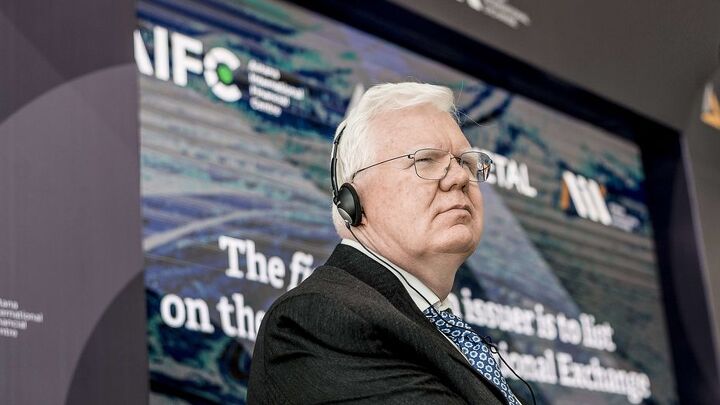NUR-SULTAN – The stock market is facing a highly uncertain economic environment. Although many experts forecasted a decrease in investment flow to developing countries during the pandemic, Kazakhstan might compensate by boosting its investment flow to other economic sectors such as mining, the Astana International Exchange (AIX) administration said during a July 2 press briefing as part of Online Astana Finance Days 2020.

AIX CEO Tim Bennet. Photo credit: AIX press service.
AIX was founded in 2017 as part of the Astana International Financial Centre (AIFC) that operates in cooperation with the Shanghai Stock Exchange and the American Nasdaq stock market. Over the past 18 months, AIX issuers have attracted $290 million in share capital.
The fall in oil prices shifted the interest of investors to mining and private companies of medium and large capitalization, which are “the most promising sectors for attracting investment in the capital market in the Central Asian region,” said AIX CEO Tim Bennett.
“We see interest in these areas both from investors and potential issuers,” Bennett added.
Kazakhstan is in the top 10 list because of its national reserves and stockpiled mineral resources. Medium and small mining companies in Kazakhstan, however, often face problems in attracting investment, said AIX Managing Director for Legal Affairs Arman Tastanbekov.
“Therefore, we are launching a new special segment that simplifies access to finance for mining companies. AIX has a high chance of repeating the success of Toronto and Sydney and becoming a regional financial center for the mining industry,” he said.
According to Bennet, many global investors, especially from developed economies, will focus on their native domestic markets as these markets have enjoyed strong support from central banks over the last couple of years. Despite the odds, Kazakhstan’s investment potential has not dimmed.
“There is still interest in opportunities in Kazakhstan. I was surprised, for example, by the huge amount of interest that we noted among institutional investors yesterday,” he said.
Bennet also positively assessed the Kazakh government’s expenses on healthcare and social assistance payments during the pandemic, which totalled about 8 percent of its gross domestic product (GDP).
“The spending [of the Kazakh government] is expected to reach up to 15 percent of GDP for the period of the economic recovery. There are questions from investors: is this approach sustainable and can the country afford it? Answering this question, I will say ‘yes.’ Kazakhstan has a fairly low level of external debt compared to other markets. Even if you spend 15 percent on the economic recovery of the country, there should not be adverse effects,” he explained.
In the next two months, AIX plans to launch a mobile application for retail investors who want a convenient and quick way to buy securities. According to Bennet, the growing Kazakh middle class is approaching the turning point where more and more individuals will start to participate in the stock market.
The number of individual investors during the pandemic is growing worldwide. Approximately 1,000 accounts are opened daily in the markets, which is four to five times more in individual markets than from the same period before the pandemic.


